Mechanical Properties and Damage Constitutive Model of Thermally Damaged Basalt
Abstract
:1. Introduction
2. Test Scheme and Test Process
2.1. Rock Sample Selection and Heating Process
2.2. Test Equipment and Method
- (1)
- Uniaxial loading
- (2)
- Acoustic emission monitoring
3. Mechanical Properties of Thermally Damaged Basalt
3.1. The Apparent Morphology and Failure Mode of Basalt after High-Temperature Exposure
3.2. Mechanical Properties of Basalt under Different Temperatures
4. Acoustic Emission Characteristics of Thermally Damaged Basalt
4.1. Acoustic Emission Peak Frequency
4.2. Acoustic Emission Ringing Count
5. Damage Evolution Law and Constitutive Model of Basalt
5.1. Damage Variable and Evolution Law of Basalt
5.2. Constitutive Model Based on Acoustic Emission Parameters
5.2.1. Constitutive Model of Crack-Closure Stage
5.2.2. Constitutive Model Based on Acoustic Emission Parameters after Crack Closure
5.2.3. Stress–Strain Constitutive Model of the Whole Process
5.2.4. Discussion on Constitutive Model
6. Conclusions
- Examining the stress–strain relationship reveals that as the temperature rises, the trend of the curve becomes more gradual, with a broader range of change above 700 °C, and the highest strain exhibits a steady growth pattern, suggesting that elevated temperatures enhance the flexibility of basalt samples. The curve after 1100 °C has stress fluctuation, showing certain plastic characteristics.
- Analyzing the peak frequency distribution of sound emissions during the loading stage shows that high temperatures significantly affect the expansion speed and size of cracks in the basalt-loading stage. Fissures caused by thermal damage shorten the time it takes for small cracks to form in the initial stage of rock samples, accelerating their expansion but limiting their total spread, providing a vital theoretical basis for identifying initial indicators of rock fracture instability after exposure to high temperatures.
- As the temperature reaches 1100 °C and the treatment temperature rises, the rock sample’s mode of failure shifts from shear to tensile failure, accompanied by various crack types in the failure area. Variations in fracture patterns are linked to the presence of tensile and shear cracks. Simultaneously, a comparative study shows that the critical temperature for the phase change in basalt mineral lies between 700 °C and 900 °C.
- Elevated temperatures lead to heat-induced harm to basalt, resulting in the rock specimen exhibiting active acoustic emissions during the early loading phase. Furthermore, as elevated temperatures enhance the rock’s malleability, the gradual breakdown process slows down compared to room temperature due to heightened strain, and the acoustic emission factors, like the rate of ringing, remain relatively stable at room temperature.
- There are four distinct phases in the development of damage in rock specimens under standard temperature scenarios. After high-temperature processing, rock samples initially suffer more thermal harm, and as the temperature increases, so does the initial thermal damage and the rate of damage development.
- Utilizing the negative exponential model, grounded in effective medium theory and acoustic emission parameters, the strain point for crack closure was established. Following this, it was integrated with two theoretical models to create a comprehensive process constitutive model, encompassing the definition of acoustic emission parameters and considering the crack-closure phenomenon. Relative to the test curve, the model’s overall accuracy is commendable, accurately representing every key mutation point on the stress–strain curve and proving useful for analyzing rock’s failure under elevated temperatures.
Author Contributions
Funding
Institutional Review Board Statement
Informed Consent Statement
Data Availability Statement
Acknowledgments
Conflicts of Interest
References
- Xu, M.; Yi, Q.; Shan, Y.; Xiong, S.; Cao, H.; Yi, S. Collaborative quality-value modelling of nuclear power equipment intelligent manufacturing based on system power flow diagram. J. Mech. Eng. 2022, 58, 270–282. [Google Scholar]
- Meng, Y.C.; Wu, H.S. World’s nuclear power plants in 2021. Foreign Nucl. News 2022, 21, 26–31. [Google Scholar]
- Zhang, Q.C.; Jiang, Y.S.; Zhao, X.; Zhang, Y.P.; Zhao, K.; Zhang, B.B.; Lu, D.Z.; Huang, Y.L. Research progress on the hazards of high-level nuclear waste radiation to the deep geological disposal environment and storage tank materials. Equip. Environ. Eng. 2022, 19, 86–93. [Google Scholar]
- Qiao, J.; Wang, G.; Song, L.; Liu, X.; Zhou, C.; Niu, Y.; Liu, B. Mechanical properties and the mechanism of microscopic thermal damage of basalt subjected to high-temperature treatment. Nat. Hazards. 2024, 120, 41–61. [Google Scholar] [CrossRef]
- Wong, L.N.Y.; Zhang, Y.; Wu, Z. Rock strengthening or weakening upon heating in the mild temperature range? Eng. Geol. 2020, 272, 105619. [Google Scholar] [CrossRef]
- Wu, Y.; Li, X.-Z.; Huang, Z.; Wang, Y.-C.; Deng, L.-C. Effect of thermal damage on tensile strength and microstructure of granite: A case study of Beishan, China. Geomech. Geophys. Geo Energy Geo Resour. 2021, 7, 82. [Google Scholar] [CrossRef]
- Wagner, H. Deep mining: A rock engineering challenge. Rock Mech. Rock Eng. 2019, 52, 1417–1446. [Google Scholar] [CrossRef]
- Shen, Y.-J.; Hao, J.-S.; Hou, X.; Yuan, J.-Q.; Bai, Z.-P. Crack propagation in high-temperature granite after cooling shock: Experiment and numerical simulation. Bull. Eng. Geol. Environ. 2021, 80, 5831–5844. [Google Scholar] [CrossRef]
- Zhao, X.G.; Xu, H.R.; Zhao, Z.; Guo, Z.; Cai, M.; Wang, J. Thermal conductivity of thermally damaged Beishan granite under uniaxial compression. Int. J. Rock Mech. Min. Sci. 2019, 115, 121–136. [Google Scholar] [CrossRef]
- Tang, Z.C.; Sun, M.; Peng, J. Influence of high temperature duration on physical, thermal and mechanical properties of a fine-grained marble. Appl. Therm. Eng. 2019, 156, 34–50. [Google Scholar] [CrossRef]
- Gautam, P.; Verma, A.; Jha, M.; Sharma, P.; Singh, T. Effect of high temperature on physical and mechanical properties of Jalore granite. J. Appl. Geophys. 2018, 159, 460–474. [Google Scholar] [CrossRef]
- Yin, T.; Chen, Y.; Li, X.; Li, Q. Effect of high temperature and strain rate on the elastic modulus of rocks: A review. Int. J. Earth Sci. 2021, 110, 2639–2660. [Google Scholar] [CrossRef]
- Zhu, Z.; Jiang, G.; Tian, H.; Dou, B. Research on statistical thermal damage constitutive model of rock based on Normal distribution. J. Cent. South Univ. 2019, 50, 1411–1418. [Google Scholar]
- Liu, W.; Dan, Z.; Jia, Y.; Zhu, X. On the statistical damage constitutive model and damage evolution of hard rock at high-temperature. Geotech. Geol. Eng. 2020, 38, 4307–4318. [Google Scholar] [CrossRef]
- Zhu, Y.; Yu, J.; Cai, Y.; Tang, X.; Yao, W.; Liu, X. A novel fatigue damage model of rock considering temperature effects. Adv. Civ. Eng. 2020, 2020, 8838335. [Google Scholar] [CrossRef]
- Wang, F.; Konietzky, H. Thermo-mechanical properties of granite at elevated temperatures and numerical simulation of thermal cracking. Rock Mech. Rock Eng. 2019, 52, 3737–3755. [Google Scholar] [CrossRef]
- Wang, S.; Liao, H.; Chen, Y.; Fernández-Steeger, T.M.; Du, X.; Xiong, M.; Liao, S. Damage evolution constitutive behavior of rock in thermo-mechanical coupling processes. Materials 2021, 14, 7840. [Google Scholar] [CrossRef] [PubMed]
- Qin, Y.; Tian, H.; Xu, N.-X.; Chen, Y. Physical and mechanical properties of granite after high-temperature treatment. Rock Mech. Rock Eng. 2020, 53, 305–322. [Google Scholar] [CrossRef]
- Takarli, M.; Prince, W.; Siddique, R. Damage in granite under heating/cooling cycles and water freeze–thaw condition. Int. J. Rock Mech. Min. Sci. 2008, 45, 1164–1175. [Google Scholar] [CrossRef]
- Xu, X.L.; Zhang, Z.Z. Acoustic emission and damage characteristics of granite subjected to high temperature. Adv. Mater. Sci. Eng. 2018, 2018, 8149870. [Google Scholar] [CrossRef]
- Altindag, R.; Güney, A. ISRM suggested method for determining the shore hardness value for rock. Int. J. Rock Mech. Min. Sci. 2006, 43, 19–22. [Google Scholar] [CrossRef]
- Zhang, W.; Sun, Q.; Hao, S.; Geng, J.; Lv, C. Experimental study on the variation of physical and mechanical properties of rock after high temperature treatment. Appl. Therm. Eng. 2016, 98, 1297–1304. [Google Scholar] [CrossRef]
- De Groot, P.J.; Wijnen, P.A.M.; Janssen, R.B.F. Real-time frequency determination of acoustic emission for different fracture mechanisms in carbon/epoxy composites. Compos. Sci. Technol. 1995, 55, 405–412. [Google Scholar] [CrossRef]
- Ge, Z.; Sun, Q. Acoustic emission (AE) characteristics of granite after heating and cooling cycles. Eng. Fract. Mech. 2018, 200, 418–429. [Google Scholar] [CrossRef]
- Liu, B.; Huang, J.; Wang, Z.; Liu, L. Study on damage evolution and acoustic emission characteristics of coal rock under uniaxial compression. Chin. J. Rock Mech. Eng. 2009, 28, 3234–3238. [Google Scholar]
- Peng, J.; Rong, G.; Cai, M.; Zhou, C.-B. A model for characterizing crack closure effect of rocks. Eng. Geol. 2015, 189, 48–57. [Google Scholar] [CrossRef]
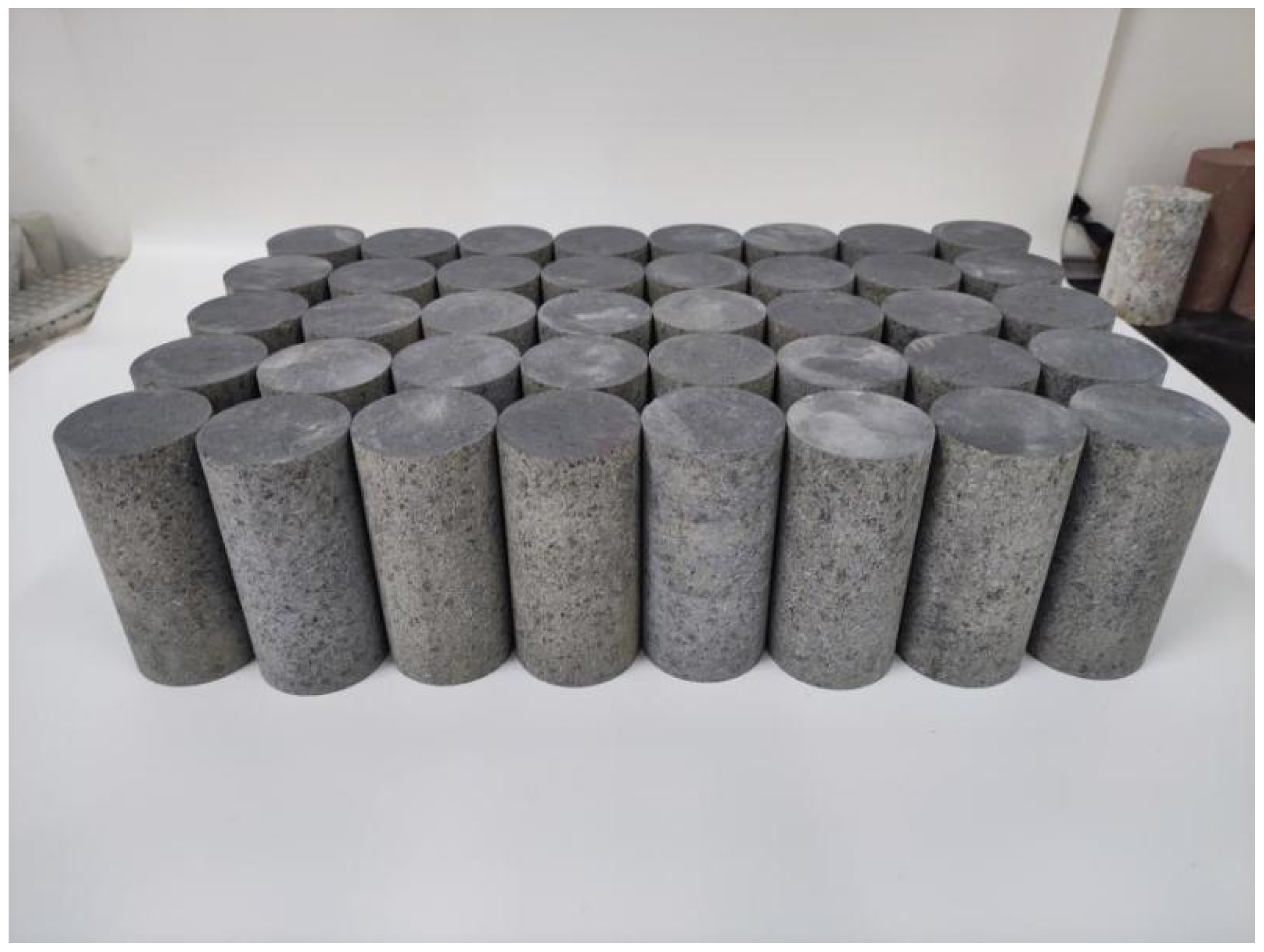





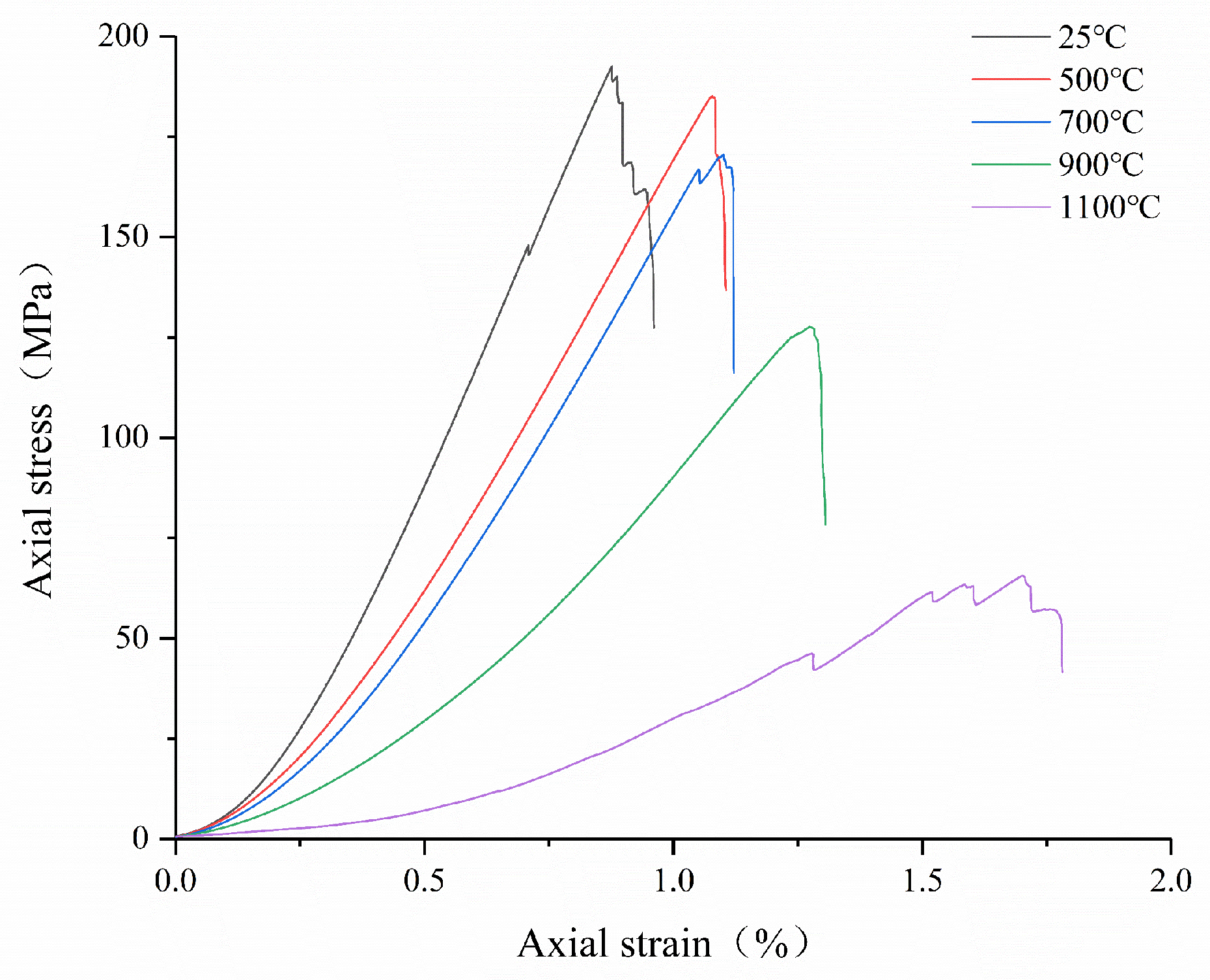

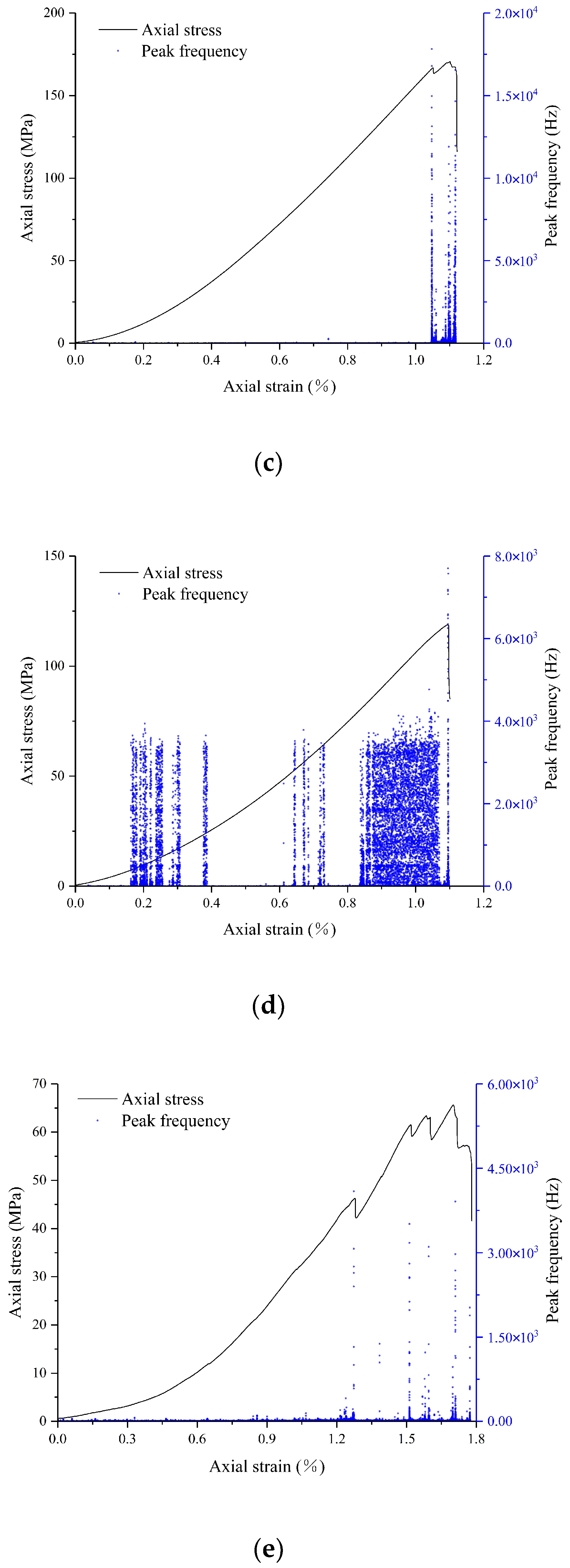


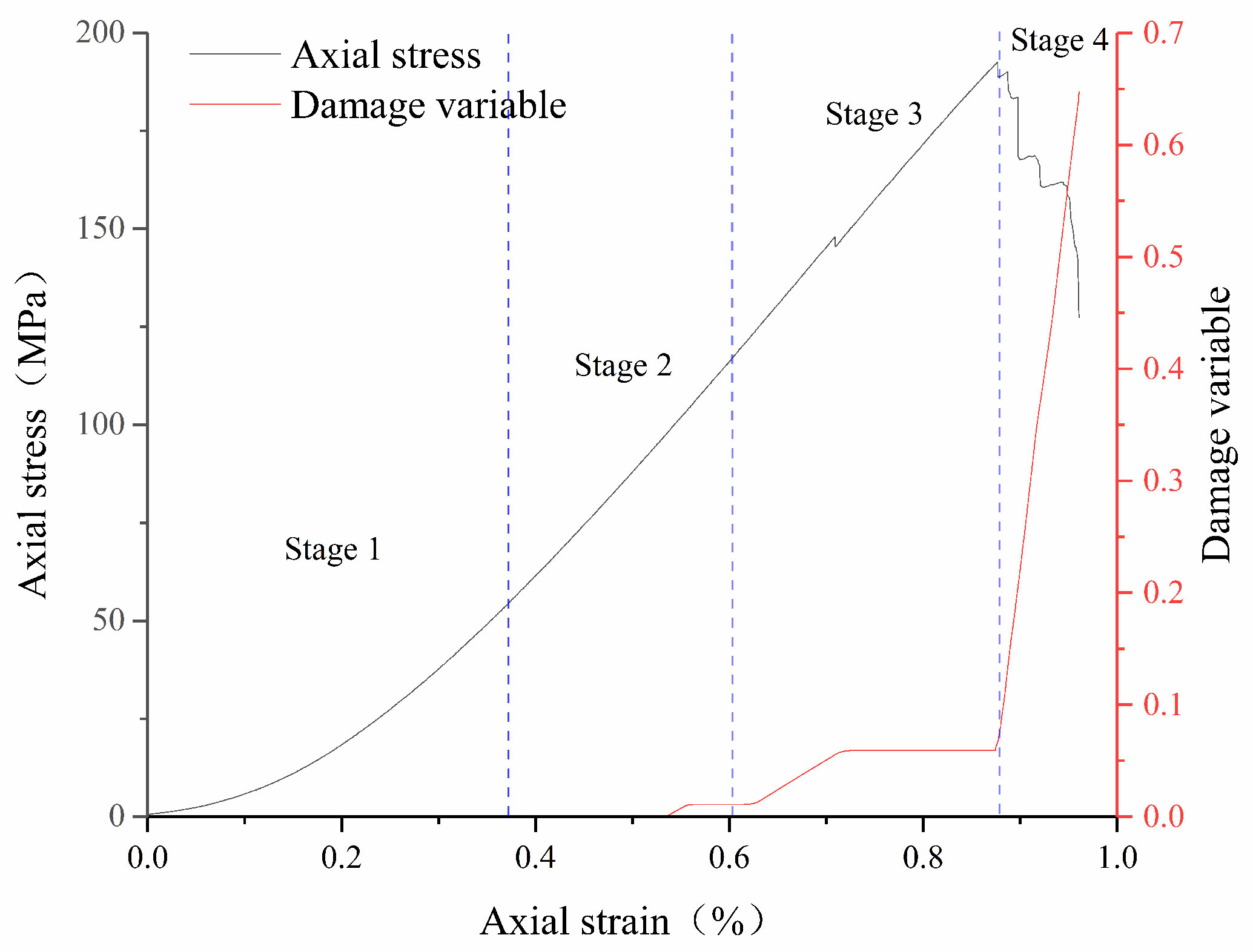
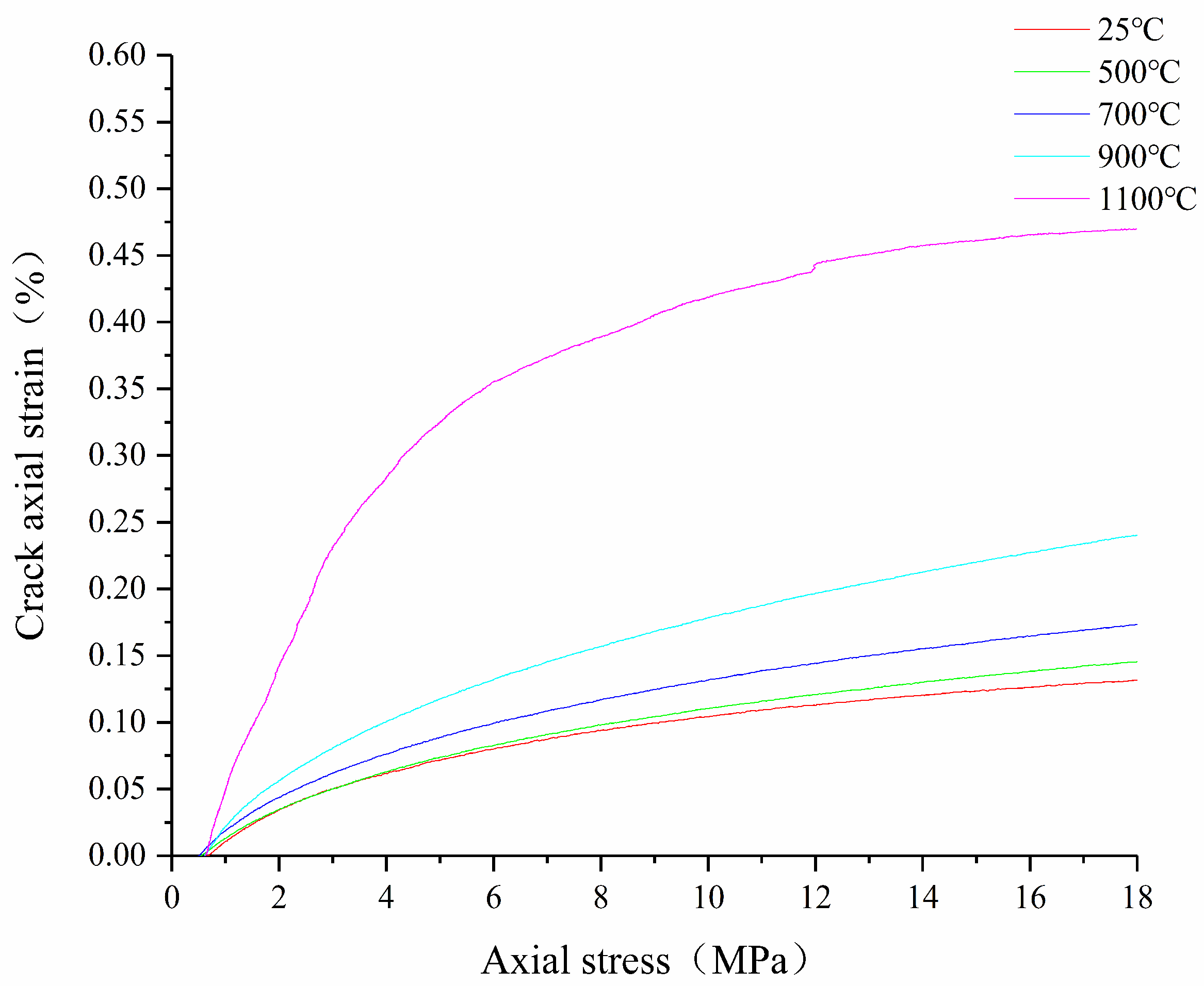
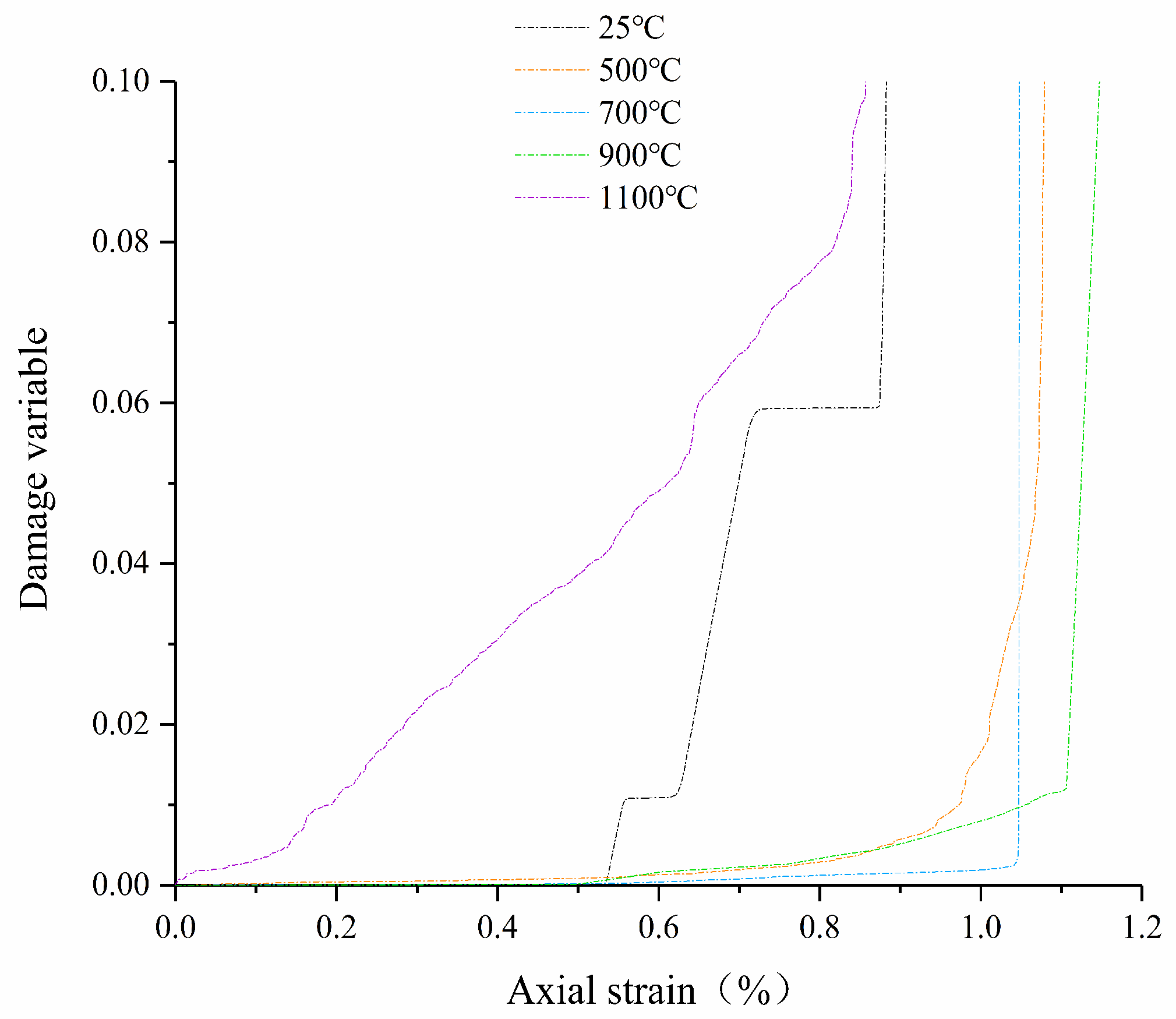
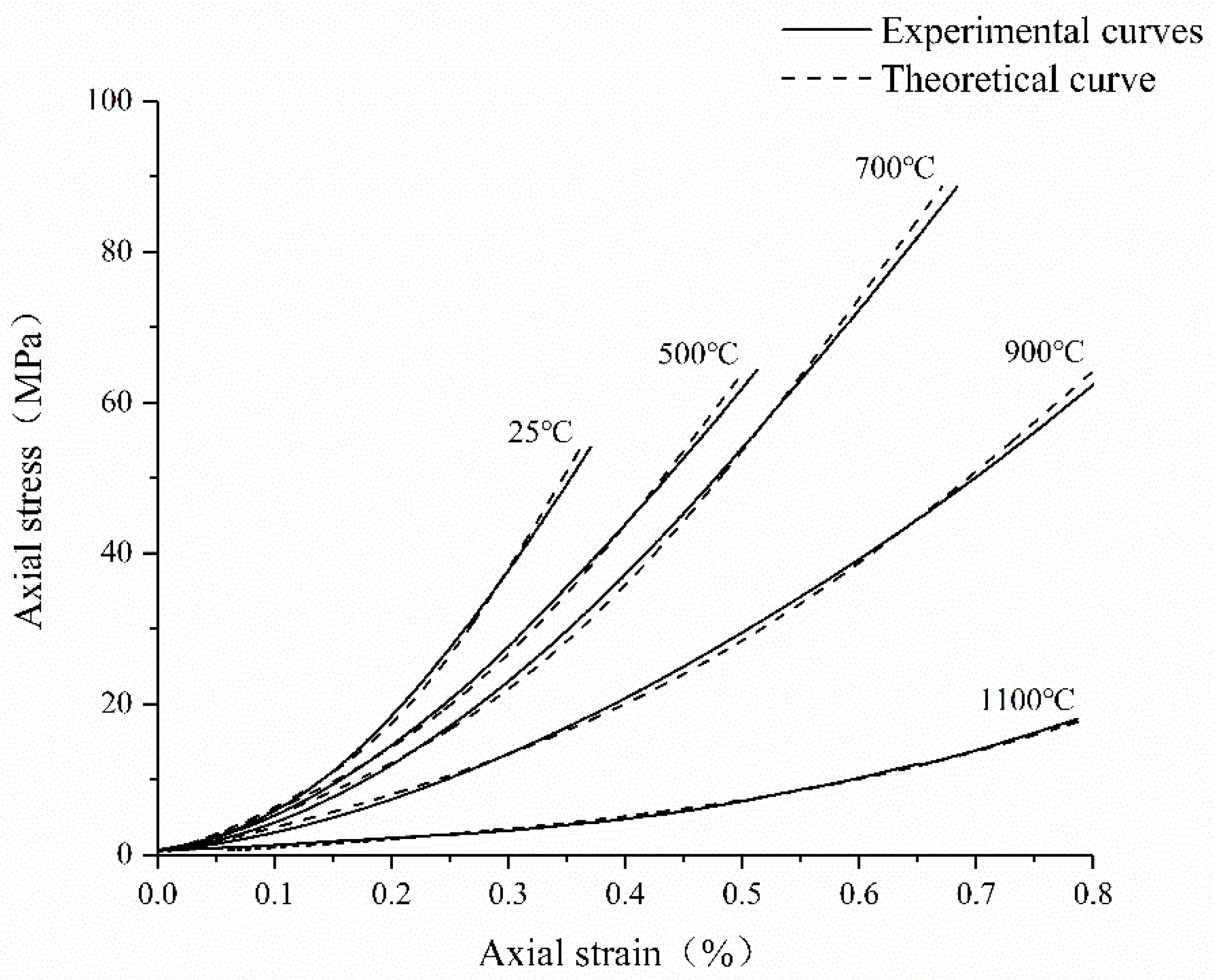
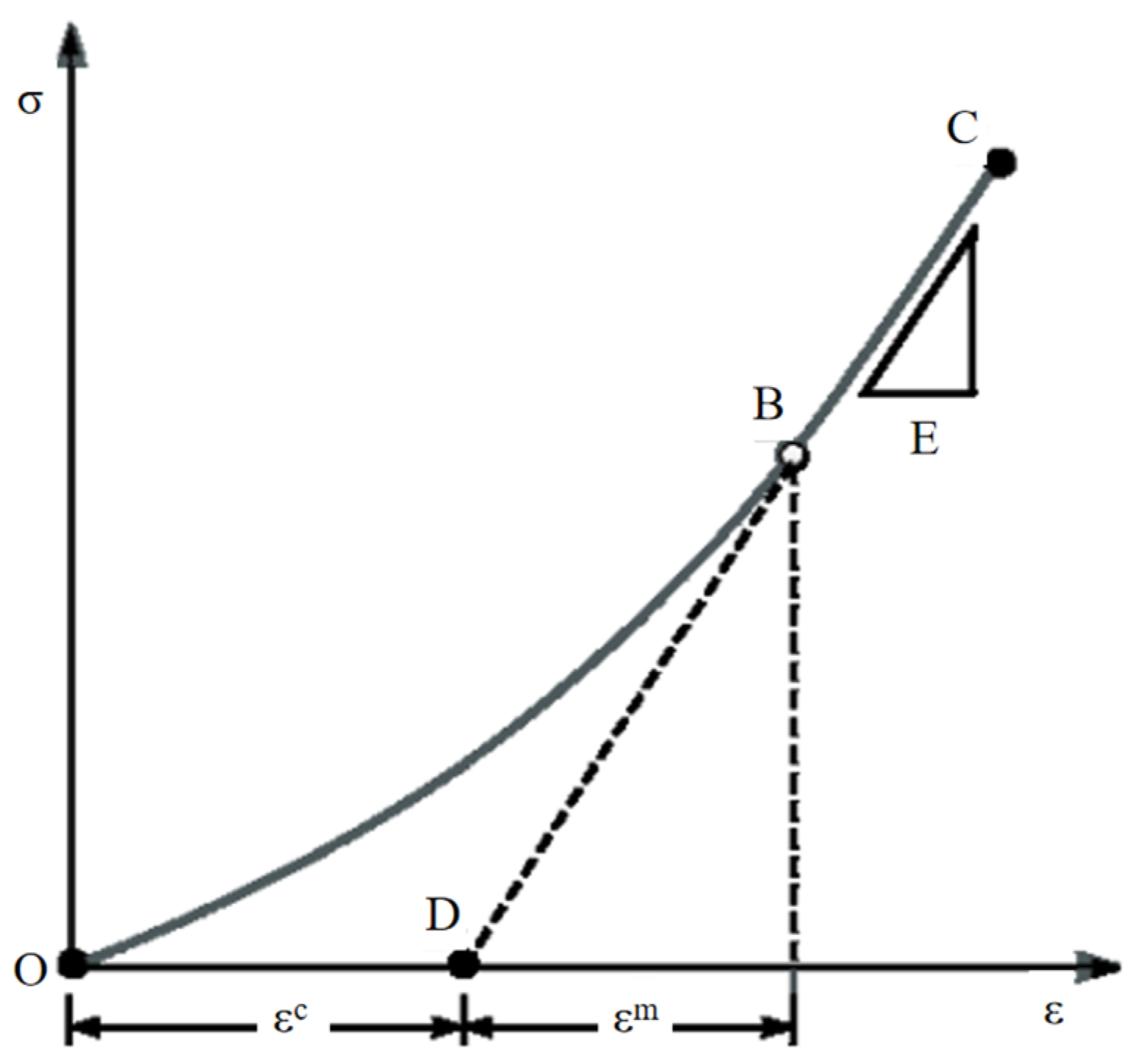
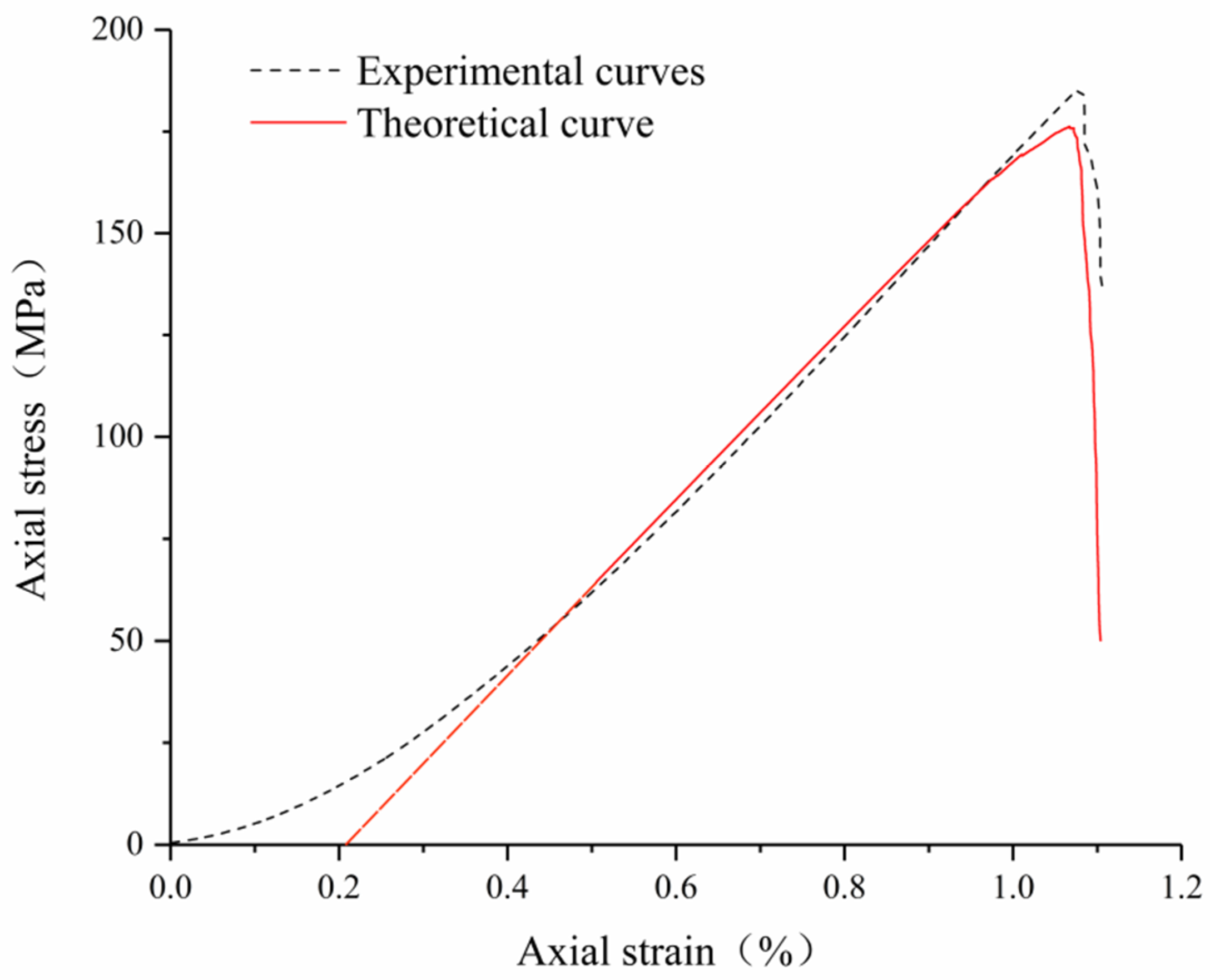
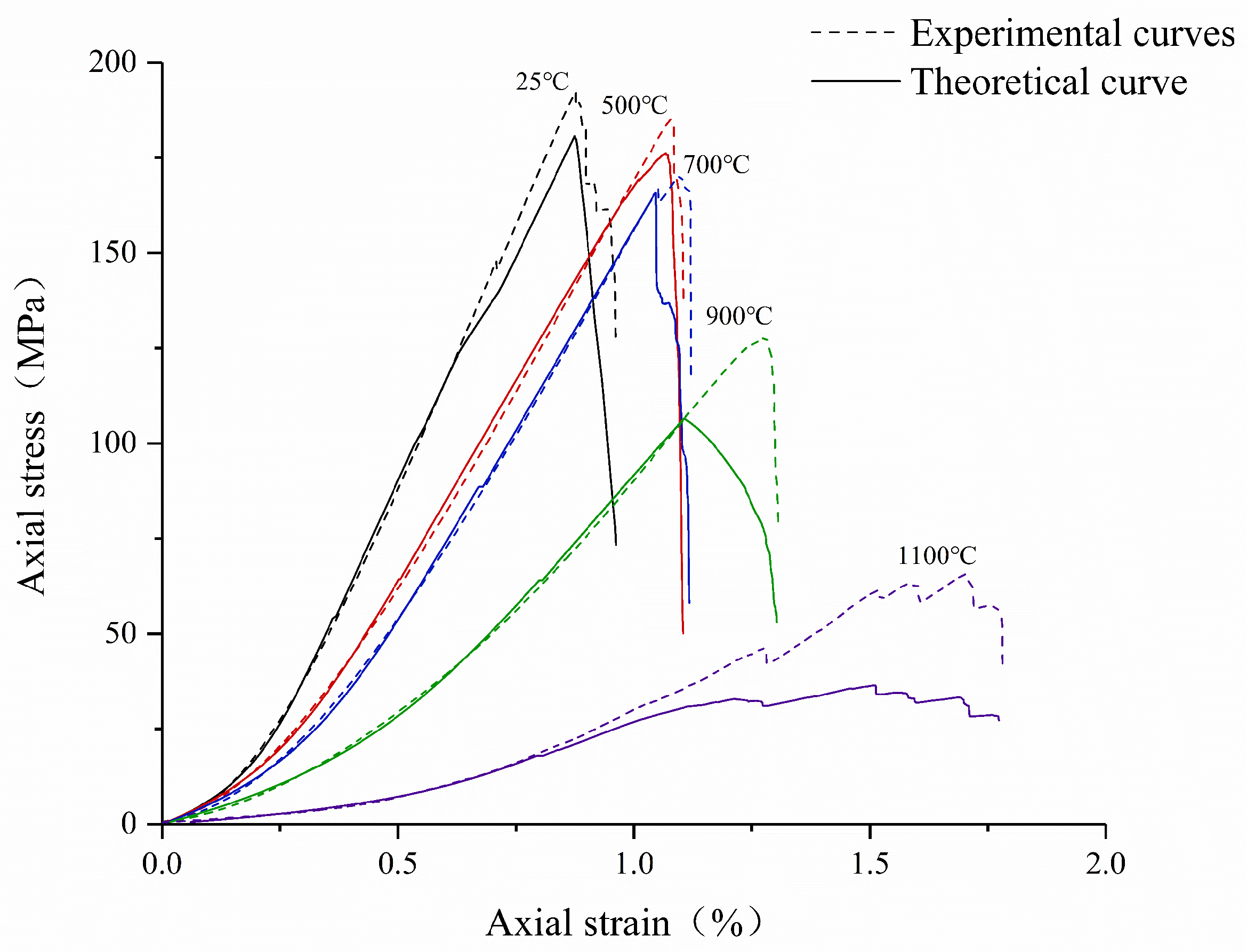
| Temperature/°C | Peak Strength/MPa | Elastic Modulus/MPa | a/% | b/MPa | R2 |
|---|---|---|---|---|---|
| 25 | 192.56 | 271.98 | 0.164 | 9.889 | 0.99 |
| 500 | 185.04 | 213.94 | 0.203 | 13.35 | 0.99 |
| 700 | 170.54 | 212.21 | 0.254 | 14.81 | 0.98 |
| 900 | 127.63 | 145.16 | 0.364 | 15.73 | 0.99 |
| 1100 | 65.64 | 56.91 | 0.493 | 5.145 | 0.98 |
Disclaimer/Publisher’s Note: The statements, opinions and data contained in all publications are solely those of the individual author(s) and contributor(s) and not of MDPI and/or the editor(s). MDPI and/or the editor(s) disclaim responsibility for any injury to people or property resulting from any ideas, methods, instructions or products referred to in the content. |
© 2024 by the authors. Licensee MDPI, Basel, Switzerland. This article is an open access article distributed under the terms and conditions of the Creative Commons Attribution (CC BY) license (https://creativecommons.org/licenses/by/4.0/).
Share and Cite
Chen, W.; Chang, R.; Liu, X.; Chang, Y.; Zhang, F.; Li, D.; Wang, Z. Mechanical Properties and Damage Constitutive Model of Thermally Damaged Basalt. Sustainability 2024, 16, 3570. https://doi.org/10.3390/su16093570
Chen W, Chang R, Liu X, Chang Y, Zhang F, Li D, Wang Z. Mechanical Properties and Damage Constitutive Model of Thermally Damaged Basalt. Sustainability. 2024; 16(9):3570. https://doi.org/10.3390/su16093570
Chicago/Turabian StyleChen, Wenzhao, Rui Chang, Xiqi Liu, Yan Chang, Fuqing Zhang, Dongwei Li, and Zhenhua Wang. 2024. "Mechanical Properties and Damage Constitutive Model of Thermally Damaged Basalt" Sustainability 16, no. 9: 3570. https://doi.org/10.3390/su16093570






